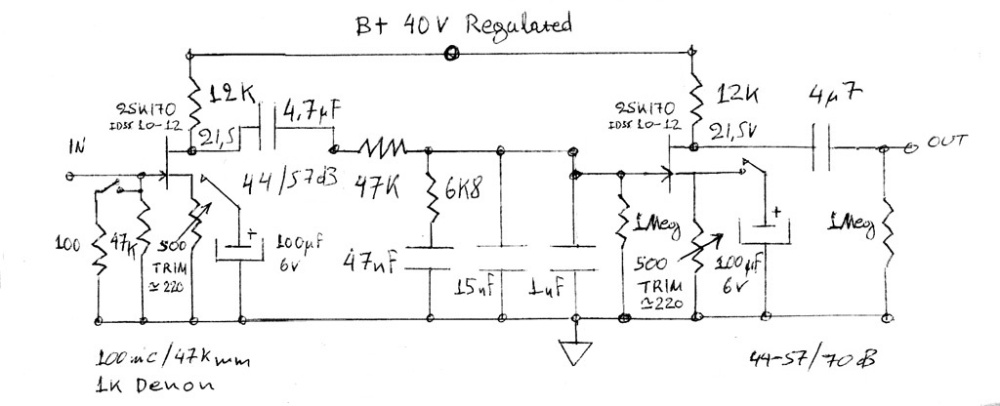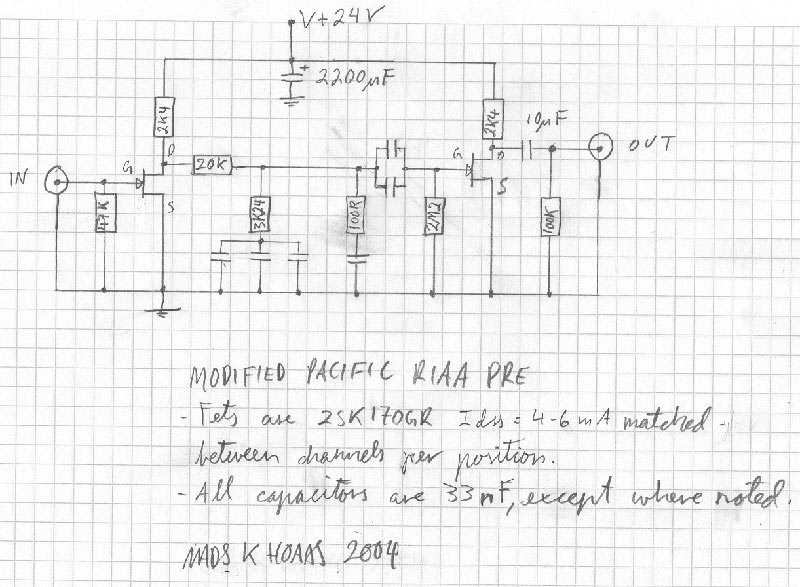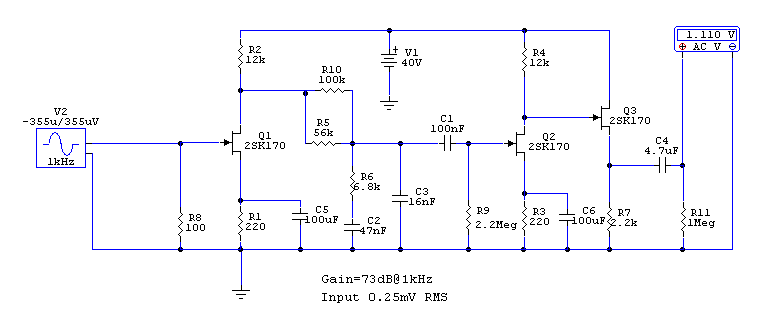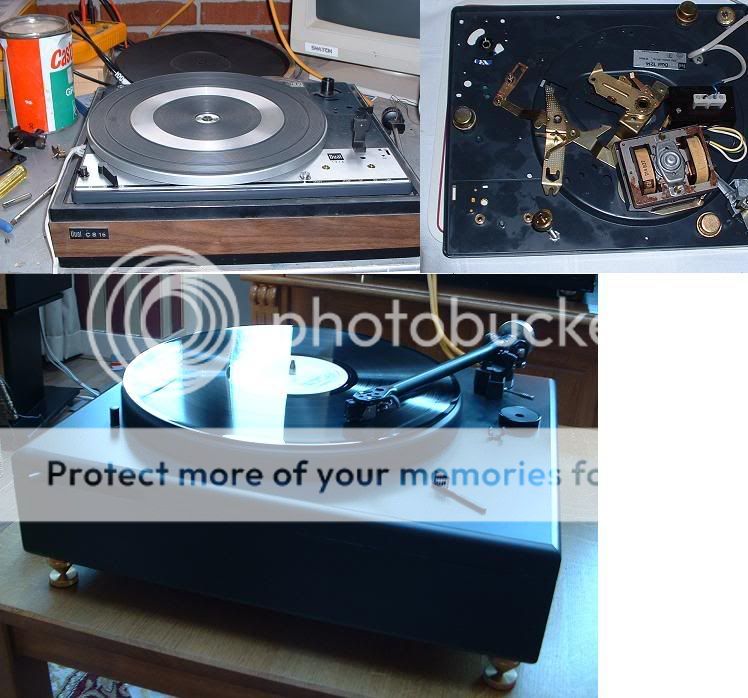Hi,
I have to try other phono-stage designs.
My own I build back in the eighties , it was a low noise design 87dB. I think it can sound much better only never came to make a better one.
To save time would you be so nice and advise me your DIY phono-stage that is very satisfying. And is recommended to copy.
Regards, Helmuth
I have to try other phono-stage designs.
My own I build back in the eighties , it was a low noise design 87dB. I think it can sound much better only never came to make a better one.
To save time would you be so nice and advise me your DIY phono-stage that is very satisfying. And is recommended to copy.
Regards, Helmuth
Salas one, would be my recommendation.
Hi Vgeorge,
With what turntable and cartridge are you using Salas his design?
Do you mean this one.

I made in 2005 something similar to that one I had not enough amplification and difference in amplification between left and right i didn't solve the problems because with two Jfets I could not raise amplification to 28dB.
This one is similar to the Salas one maybe the second Fet has to be replaced to by a two stage bipolar transistor end-stage to get higher amplification. And raise the power supply to 40 volt.

Or this one.
An externally hosted image should be here but it was not working when we last tested it.
All these designs have Jfets to get low noise but they use 680K and 1meg resistors. Resistors make noise to.
POWER SPECTRAL DENSITY
The Power Spectral Density simply describes how much noise power would generated by a resistor in a 1 Hz bandwidth.
S = 4 k T R (V2/Hz)
where
S = the noise Power Spectral Density
k = Boltzmans constant (1.38∙10-23)
T = temperature in Kelvin (Room temp = 27 °C = 300 K)
R = resistance
With raise of bandwidth and Resistance and temperature the noise level of the resistor raises.
This means with the given designs after the first correction one would need a buffer stage so we can use lower resistors.
http://www.ecircuitcenter.com/Circuits/Noise/Noise_Analysis/res_noise.htm
The last design looks nice with J1 and J2 that make a srpp I believe. Only J3 shout be used as buffer with gate to R5. And a opamp lme49860 to get the right amplification, Only a thought.
Last edited:
Correction above I said 28dB I mean 56dB.
Salas already did here a buffer in the end-stage. I think a good opamp would be fine as buffer with the nice Jfet prestage.

Salas already did here a buffer in the end-stage. I think a good opamp would be fine as buffer with the nice Jfet prestage.

Last edited:
I use a Shelter 901 with a VPI Aries turntable.
What do you use and you need a higher gain?
Read here : http://www.diyaudio.com/forums/analogue-source/129126-simplistic-njfet-riaa-248.html#post2308275
You can find an MC pre-pre if you need it.
Also if I could, I would avoid opamp buffers.
What do you use and you need a higher gain?
Read here : http://www.diyaudio.com/forums/analogue-source/129126-simplistic-njfet-riaa-248.html#post2308275
You can find an MC pre-pre if you need it.
Also if I could, I would avoid opamp buffers.
If you want to go the tube route and some expense/complication doesn't scare you, take a look at His Master's Noise over in the Articles section.
I can see you have done serious investment in de phono equipment. And do conclude your looking for the best. There is a huge chance that I will adopted Salas design.I use a Shelter 901 with a VPI Aries turntable.
What do you use and you need a higher gain?
Read here : http://www.diyaudio.com/forums/analogue-source/129126-simplistic-njfet-riaa-248.html#post2308275
You can find an MC pre-pre if you need it.
Also if I could, I would avoid opamp buffers.
I see that Salas is surprised and pleased with the results of the design. It is simple I like that (like a mentioned I did some thing similar with a 2n3819). For my own design I listened to it worked it did not sound special as far I tested it.
There for a first impression can of a sound can be misleading, when listened to it for a long time.
Regards helmuth
Last edited:
I have interest but I do not see a advantage in using a tube to a Jfet. Not based on any experience though.If you want to go the tube route and some expense/complication doesn't scare you, take a look at His Master's Noise over in the Articles section.
Why would the tube version be better SY?
The design you're advising is complex and with transformer input also expensive. The measurements are amazing good.
Triode dick has a tube phone stage on the web. No measurements.
Last edited:
Any one uses this design. Probably to minimal design. I like his philosophy and prise.
http://boozhoundlabs.com/kits/jfet-phono/Boozhound-Laboratories-JFET-Phono-Preamp.pdf
http://boozhoundlabs.com/kits/jfet-phono/Boozhound-Laboratories-JFET-Phono-Preamp.pdf
Attachments
Why would the tube version be better SY?
Overload margins and linearity, and the transformer input gives high common mode rejection and galvanic isolation. As you noted, despite the absence of any feedback loops and a simple passive equalization, the performance is very good. And yes, as you noted, not terribly cheap to build, especially if you want good transformers. Just throwing it out as a suggestion- as you see, there are a lot of good options using all different sorts of design approaches.
What about RJM's VSPS etc... they are pretty nice too, if you can get past the stigma of opamps.
Helmuth,
don' t forget that Salas shunt regulator is a major part of the performance.
Few people have built it and are very happy with it.
don' t forget that Salas shunt regulator is a major part of the performance.
Few people have built it and are very happy with it.
I would build one if in a blind test it performs the same as a discrete one.What about RJM's VSPS etc... they are pretty nice too, if you can get past the stigma of opamps.
Dare I suggest in this discrete company, an opamp design? I'd grab the National application note on preamps made using the LME49710. It's hard to top those designs in any measurable way; IMHO, the real issues in preamp design have to do with passive component quality (caps), layout and wiring, as much as the circuit. Gain distribution and overload issues also need to be examined, but they're not as much of a problem in most systems as some would have you believe.
Dare I suggest in this discrete company, an opamp design? I'd grab the National application note on preamps made using the LME49710. It's hard to top those designs in any measurable way; IMHO, the real issues in preamp design have to do with passive component quality (caps), layout and wiring, as much as the circuit. Gain distribution and overload issues also need to be examined, but they're not as much of a problem in most systems as some would have you believe.
I am thinking about a 2sk170 input and lme49860 output simple and as you state probably unbeatable specs.
Like SY mentioned, in a phono preamp, linearity and overload margins are everything, apart from low noise. I'd stick to JFETs and tubes and skip the opamps.
Whoeho
I just bought this one



I will dismantle this project from its RB301 arm with van de Hul silver wiring and fit it to the TD124.

I just bought this one




An externally hosted image should be here but it was not working when we last tested it.
I will dismantle this project from its RB301 arm with van de Hul silver wiring and fit it to the TD124.

Last edited:
Like SY mentioned, in a phono preamp, linearity and overload margins are everything, apart from low noise. I'd stick to JFETs and tubes and skip the opamps.
How would you describe the sound of a op-amp to a Jfet/tube stage?
Here a other great TD124 on ebay usa just a tip 8hours to go:http://cgi.ebay.nl/ws/eBayISAPI.dll?ViewItem&item=290561695618&ssPageName=STRK:MEWAX:IT#ht_606wt_1141
Last edited:
My opamp based stage sounds very dead compared to the JFET one. I'm yet to build a tube stage, but I've heard one and it sounded mighty nice.
My opamp based stage sounds very dead compared to the JFET one. I'm yet to build a tube stage, but I've heard one and it sounded mighty nice.
"O" is that tube one from this forum? Witch Jfet based amp you use.
Who likes to own a Garrard 401? I was looking at this one if the thorens buy would fail.
http://cgi.ebay.nl/ws/eBayISAPI.dll?ViewItem&item=140543035292&ssPageName=STRK:MEWAX:IT#ht_722wt_1141
Last edited:
- Status
- Not open for further replies.
- Home
- Source & Line
- Analogue Source
- Which DIY phono-stage gives great results?
